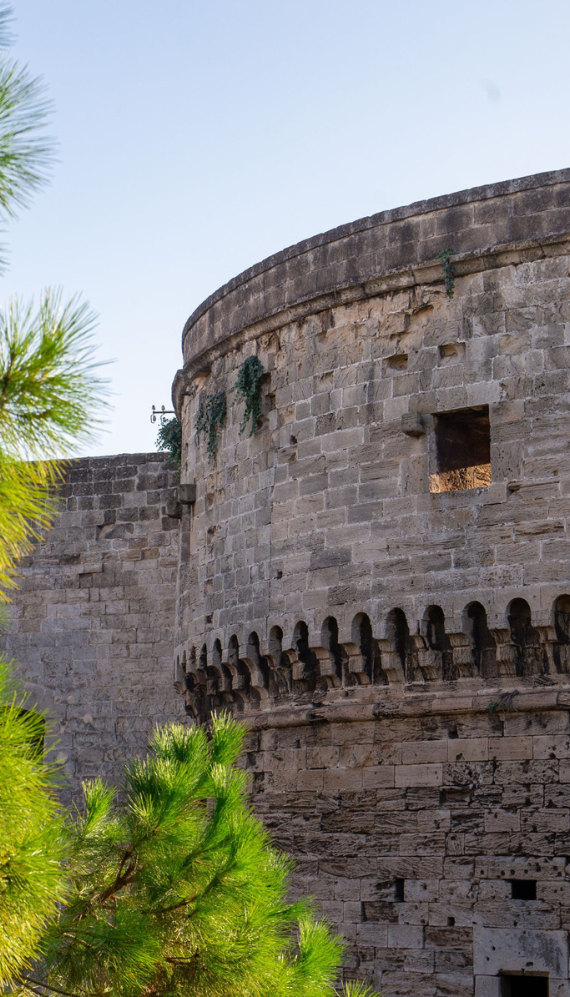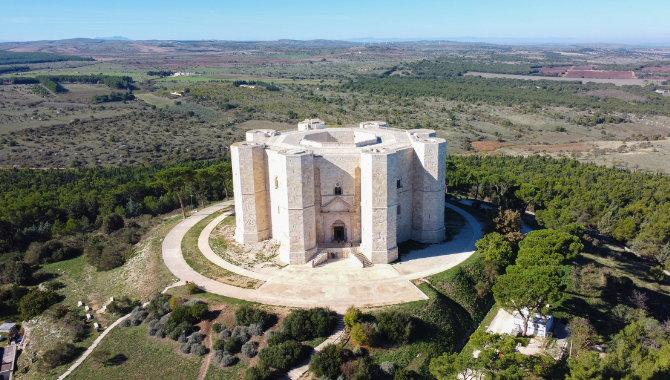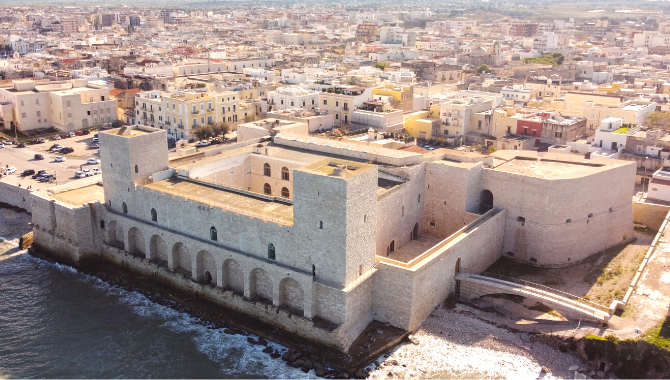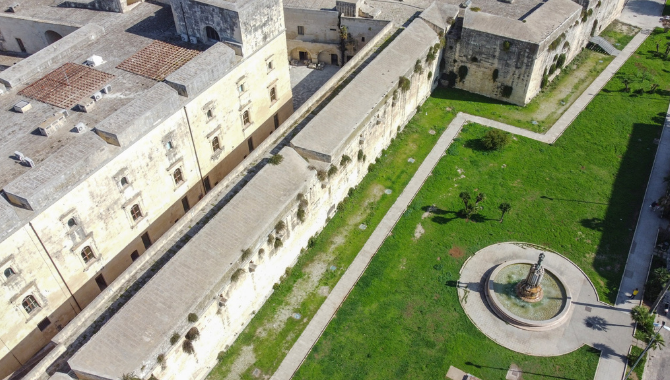
The Apulian castles, symbol of a territory
Itinerary description
Trani Castle was built on the model of the Crusader castles of the Holy Land, in turn debtors of the Roman castra, with a quadrangular plan, reinforced at the top by four square towers of equal height. In the 16th century, with the advent of firearms, the castle was adapted to the new defensive techniques, after which it was again subject to adaptation work in the 19th century for the prison function. In the 1970s it was handed over to the Ministry of Public Education, now the Ministry of Cultural Heritage and Activities, which oversaw its restoration and museum display.
Castel del Monte represents the most prestigious example of architecture under Frederick II which stands out imposingly and with a component between the mysterious and the enigmatic on a hill of the Murge: the latter was a residence inhabited by the monarch, and still today, it is considered one of the most precious and perfect examples of medieval art and architecture.
The Aragonese Castle, called Castel S. Angelo, is located near an ancient natural depression of the rock bank above which the ancient village of the city stands and basically consists of an Aragonese reconstruction of a previous Norman-Swabian-Angevin fortress built in the same point but having very different characteristics since it was a typical medieval castle with numerous tall and thin towers built on top of a previous Byzantine fortification which had the foundations resting on structures dating back to the Greek period (4th-3rd century BC).
The Castle of Emperor Charles V of Habsburg was built in 1539, following the issuing of the order to demolish the old princely bulwark, dating back to the Middle Ages, and to build a new fortress, avant-garde with military architecture techniques . The construction and design works were entrusted to Gian Giacomo dell'Acaya, general engineer of the Kingdom of Naples.
To date, at least three entrance gates to the castle seem to be documented: the "Prima Porta" or primus introitus (record of 1463), which now opens onto Piazza Libertini, probably the "Porta Regale" mentioned in 1544-5; the "Porta ferrata" or the versus civitatem gate (1463), which opens onto the city; the so-called "false door" (1463), next to the Magistra Tower.
Travel duration
More than 6 hours
Points of interest
Castel del Monte
Andria and its castle are inextricably linked to the great history of Frederick II.
Tradition has it that Frederick II gave Andria the nickname "Fidelis", as on returning from the sixth crusade the city proved faithful by giving him the access keys and he, out of gratitude, freed it from the burden of taxes; His son Corrado IV was born in Andria in 1228, with his wife Jolanda of Brienne, queen of Jerusalem, who died at the age of sixteen following a childbirth. Frederick II was responsible for the construction of Castel del Monte, declared a World Heritage Site by UNESCO, located on an isolated hill in the countryside of Andria, near the Monastery of Santa Maria del Monte which already belonged to the territory of Trani.
Swabian Castle
The Castle of Trani is part of an imposing defensive system built by Frederick II of Swabia to protect the Kingdom of Sicily. It rises a short distance away from the famous cathedral, strategically located in the center of a bay, whose shallow waters have always been an excellent natural defense, both from the fury of the waves and from possible enemy attacks.
The Castle of Trani was built on the model of the Crusader castles of the Holy Land, in turn based on the Roman castra, with a quadrangular plan, reinforced at the top by four square towers of equal height. In the 16th century, with the advent of firearms, the castle was adapted with new defensive techniques, after which it was again the subject of adaptation works in the 19th century giving it prison functions. In the seventies it was handed over to the Ministry of Education, today the Ministry of Cultural Heritage and Activities, which oversaw the restoration and the creation of a museum.
The original architectural layout has a quadrangular plan, with four square towers at the top, all equally high. The external face is rusticated; on the three sides that do not overlook the sea we find a wall with three external courtyards, while a moat filled with sea water separates the castle from the mainland. Over time the castle passed into the hands of different dynasties, first the Angevins, then the Aragonese, and then, up to the present day, they became state property. Only between 1385 and 1419 the castle was assigned to the mercenary captain Alberico da Barbiano.
Aragonese Castle
The Aragonese Castle or Castel Sant’Angelo has undergone a radical evolution over time and has taken on different functions: from the Byzantine to the Aragonese era, up to the Habsburg rule that transformed it into a prison, of which disturbing traces still remain.
Of Byzantine origin, the Castle had tall and narrow towers, used to throw stones and boiling oil on the invaders. Its reconstruction is due to Ferdinand I of Naples who, in 1486, had it enlarged and above all remodeled its towers, this time low and wide in a circular shape. The reason was the introduction of a new type of weapon: the cannon. The new towers made it possible to move this new instrument of war more easily and at the same time to better cushion the blows inflicted by the enemy.
Habsburg castle of Charles V
Not far from the iconic square of the Baroque City, there is the castle of Lecce, known by all as the manor of Charles V. This fortress, however, contrary to what its name implies, was not built by the emperor of the Holy Roman Empire but it owes its construction to the Norman period and therefore dates back to the Middle Ages, a time during which the current manor was presented as a simple princely bulwark. The new castle built by Emperor Charles V did not completely erase the history of the previous fortress. Between myth and legend, we find the story of a white bear guarding a noble family.
Path
Gallery




